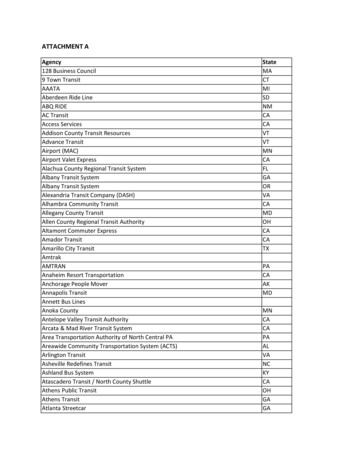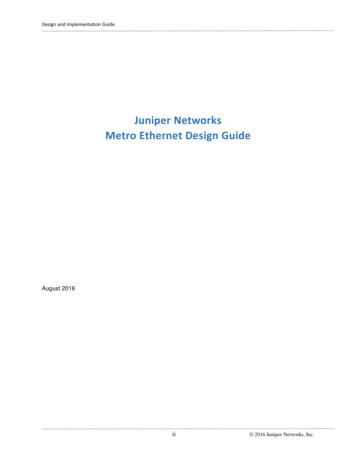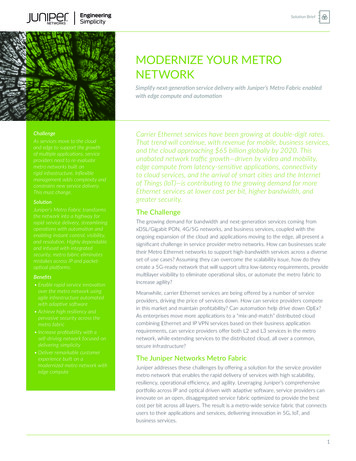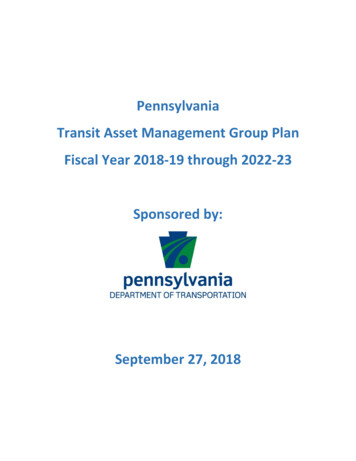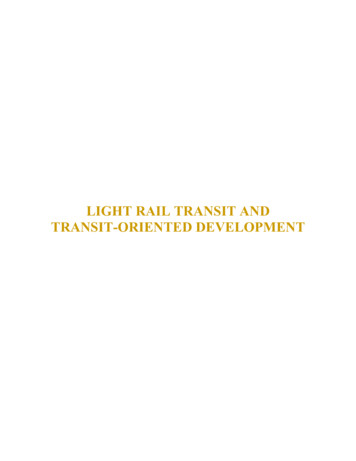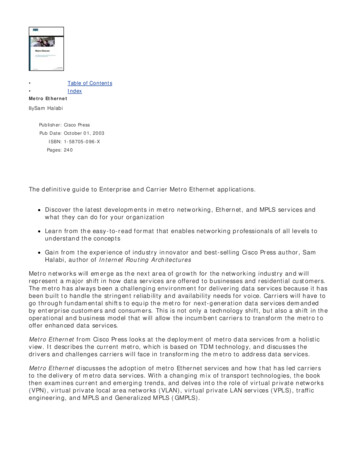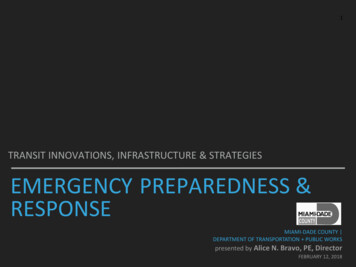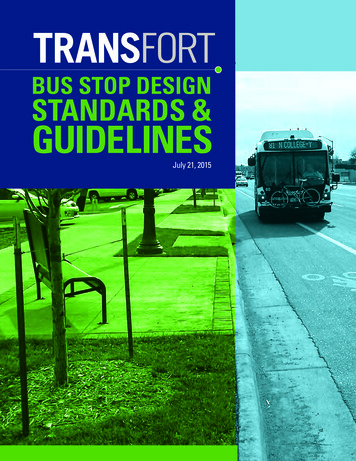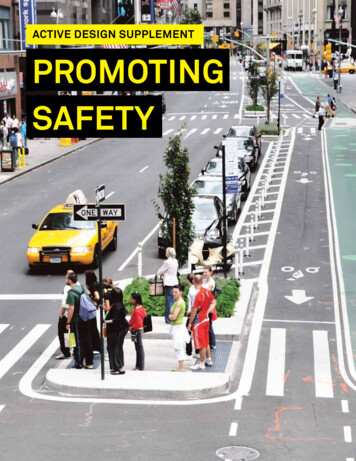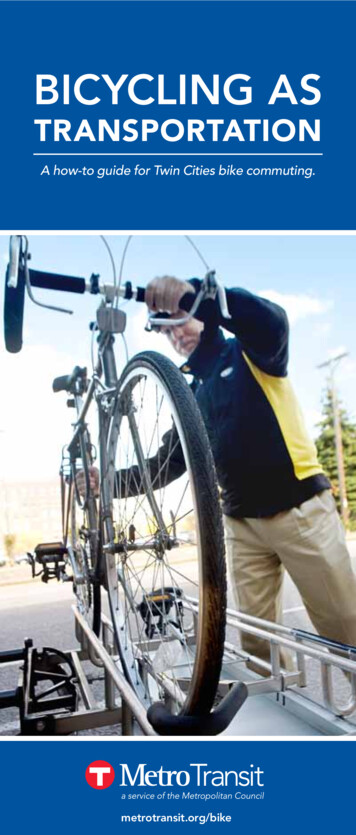
Transcription
Bicycling aStransportationA how-to guide for Twin Cities bike ke
Bicycling as TransportationVersion 2.0 December 2010, Metro TransitMetro Transit gratefully acknowledges 494 CommuterServices, Anoka County Transportation ManagementOrganization, Minneapolis Commuter Connection,St. Paul Smart Trips, Bike Walk Twin Cities and the MinnesotaDepartment of Transportation for assistance on this project.
Table of Contents5813The BenefitsSave money, stay fit, save timeReduce your impactEnjoy yourselfGetting StartedThe route, the law, the gearSafe BicyclingTraffic tips and signals17Ready for Work18CONNECTING WITH TRANSITLow impact ridingChanging clothing at workBicycle lockersGuaranteed Ride HomeBicycle racks on buses and trainsBicycle connections to Northstarmetrotransit.org/bike 3
Many people think of bicyclesas equipment for recreation,not vehicles for transportation.The truth is they’re both.Bicycling saves money, saves time and improvesfitness. Plus, a bicycle can provide a trip to work,school, the store — virtually everywhere someonemight drive. Traveling by bicycle reduces trafficcongestion and has little impact on the environment.And bicycles are fun!Bicycle commuting is easy but it does requiresome adjustments to your routine. Read onfor useful information for anyone — from the curiousto the committed — on bicycle commuting in theTwin Cities (and beyond).
The BenefitsSave moneyEvery year, the typical Twin Cities driver spendshundreds of dollars just to get to work and aroundtown. Fuel and maintenance add up fast when driversput on those miles day after day. And that doesn’tinclude parking expenses or ownership costs likedepreciation, insurance, financing, registration or taxes.In fact, the American Automobile Association (AAA)estimates that the real cost to drive one mile onaverage is 57 cents. At 15,000 miles per year, thatadds up nearly 8,500.You can save money by simply driving less. Use thesavings to invest in a bicycle and pay for maintenanceand commuter-friendly gear.Save on parking too — bring your bicycle into yourworkplace, lock it up outside or store it in a locker.For 4 per month, you can rent secure, weatherproofbicycle lockers at dozens of locations. Read moreabout bicycle lockers on page 18.1 AA derives these figures from average fuel, routine maintenance,Atires, insurance, license and registration, loan finance charges anddepreciation costs.2010 Your Driving Costs, American Automobile Association.aaaexchange.commetrotransit.org/bike 5
The Benefits (continued)Stay fitLack of activity contributes to cadiovascular disease(the #1 killer in the United States), diabetes, obesityand other conditions that decrease quality of lifeand/or reduce lifespan. Bicycling provides low-impactexercise as you travel. You choose your pace and cancontinue to ride at any age.You don’t need to schedule time for workouts orpay for a health club membership — your commuteis your workout. Plus your employer may provideincentives for bicycle commuters; ask at work.Save timeMore than 41 percent of Twin Cities trips are lessthan three miles; over a quarter are less thantwo miles.2 A bicycle is often the fastest way totake these trips.For longer trips, combining a bicycle with a bus ortrain ride can provide time-saving options. All MetroTransit buses and trains have free bicycle storageracks. Bicycling for part of the trip can eliminate theneed for transfers or allow you to reach a transit stopfaster than on foot. Or ride transit one way andride your bicycle the other (p. 19).6 2 000 Travel Behavior Inventory. Table 58A. Metropolitan TBI 2000.htm3 reen Power Equivalency Calculator Methodologies.GU.S. Environmental Protection ng as Transportation
Reduce your impactAn average passenger vehicle produces tons ofemissions each year, affecting air quality and climatechange. Because bicycle travel is virtually emissionsfree, every car trip you can replace cuts greenhousegas emissions and improves air quality. For everymile you pedal instead of driving, you save about apound of CO2, the primary greenhouse gas.3Enjoy yourselfYou’ve heard “you never forget how to ride abicycle” — the fun of riding comes back just as readily.The freedom of bicycling is a unique experience andthe pace allows you to develop a new relationshipwith the areas you travel through. Bicycling is alsoan activity that is suited to socializing — it’s easy toride and chat.metrotransit.org/bike 7
Getting StartedThe RouteLearning a good, safe route will be key to the quality ofyour commute. Although it’s legal to ride on nearlyevery roadway (except interstates or some restrictedstreets such as Marquette and 2nd avenues indowntown Minneapolis), many bicyclists prefer ridingon bikeways, trails or streets with lower speed limits orless traffic. Also consider scenery, lighting and stopsalong the way.For a new bicycle commuter, joining the CommuterChallenge program is a good way to get started.Learn more about this free program and sign up atmycommuterchallenge.org.Other resources for navigation include Cyclopath — anonline route finder — and free bicycle maps for somemetro-area counties, cities and even neighborhoods.See metrotransit.org/bike for links to these resources.Develop a route to your liking by researching differentways of getting to your destination. Note the streets thatbicyclists use and which might best meet your needs.Maybe one route is better on the way to your destinationand another is better on the way home. Toget comfortable with the timing and feel of the route(and to make sure that you are able to enjoyably ride it),practice on a weekend or during low-traffic periods.8 Bicycling as Transportation
The LawThe Minnesota Department of Transportation’s Sharethe Road campaign distills safety guidelines and much ofMinnesota bicycle law and into eight simple points:1Bicyclists may ride on all Minnesotaroads, except where restricted.2Bicyclists should ride on the road, andmust ride in the same direction as traffic.3Motorists must at all times maintain athree-foot clearance when passing a bicyclist.4Bicyclists must obey all traffic controlsigns and signals, just as motorists.5Motorists and bicyclists must yieldthe right-of-way to each other.6Bicyclists must signal their turns andshould ride in a predictable manner.7Bicyclists must use headlight and rearreflectors when it is dark. To increasevisibility, add a rear flashing light.8Bicyclists should always wear helmets.sharetheroadmn.org is a greatresource for more in-depthinformation on these pointsand a summary of all Minnesotabicycle laws.metrotransit.org/bike 9
Getting started (continued)The GearWhether you are buying a new bicycle, resurrectingan old one or having one modified for commuting,talk with the staff at local bike shops and ask lots ofquestions. The right sizing and fit are very important —many styles of bicycles are available, and not all aredesigned for the types of riding you’re interested in.Many advanced bicyclists have very specialized gear.You may find that some of this equipment is handy foryou too, but you really don’t need all of it to get startedcommuting. Here are some basic considerations:SafetyAlthough helmets are notrequired by law, wearingone can be the differencebetween life and death orserious injury in a crash.Rear reflectors (or lights)and headlights are requiredby law and are especiallynecessary for nighttimeor poor weather riding.Light-colored, bright orreflective clothing makesyou more visible to motorists. A mirror can alsoimprove your traffic awareness. Use special cautionriding at dusk – this is the most dangerous time forbicyclists. Always carry personal identification.10 Bicycling as Transportation
SecurityYou’ll want a good lock(or locks) to protect yourbicycle. Even if you can storeyour bicycle indoors or in agarage, it’s still a good ideato lock it to something.Combining a U-lock and acable lock provides extraprotection.Lockers are available for rentthrough Metro Transit, theCity of Minneapolis, theUniversity of Minnesota andsome employers as well.Find locations nearest youat metrotransit.org/bike.ComfortShoes and clothing can makea big difference in how yourride feels. Dressing for theweather and in removablelayers allows you to adapt toconditions throughout theday. Fenders keep roadwaywater and grime fromspraying you.metrotransit.org/bike 11
Getting started (continued)CargoThere are many ways tobring things with you. Abackpack works, but can beuncomfortable on longerrides. Racks and bags (suchas messenger bags orpanniers) can be used tocarry loads morecomfortably. Bottles andcages are helpful forcarrying liquids.Back-up plansCarry change for a phonecall or transit fare. Bringa cell phone. Join theGuaranteed Ride Homeprogram (p. 18). Learninghow to fix a flat tire andcarrying a spare tubeand patch kit can get youmoving again quickly —many local bike shopsprovide sessions that teachthis simple skill. There arealso many step-by-stepresources online — or askanother bicycle rider fora demo.12 Bicycling as Transportation
safe bicycling“ Cyclists fare best when they act andare treated as the drivers of vehicles.”John Forester, author of Effective CyclingAlthough bike paths are prevalent in the Twin Cities, it islikely that you will need to become comfortable riding onstreets in traffic when commuting by bicycle. Riding onsidewalks is illegal in business districts and some otherareas and is often the most dangerous option. Ridinglawfully, predictably and confidently — while indicatingyour intentions to other vehicles — is essential for safety.Traffic TipsIn general, ride in a straight line in the same directionof traffic. Ride to the right of faster moving traffic andat least three feet from the curb, parked cars or otherobstructions to make yourself visible and to avoidroadside hazards. When riding alongside parked cars,signal and move into the lane far enough to avoidopening doors. Always pass other vehicles on the left.If you must use a sidewalk or crosswalk, considerwalking your bicycle or ride very slowly. Always yieldto pedestrians and let them know you are approachingwhen passing. Be especially cautious when transitioningto and from the roadway.metrotransit.org/bike 13
safe bicycling (continued)Cross train tracks, sewer grates and other obstructions ata right angle and transition your weight toward the backof the bicycle to prevent getting your wheel caught, whichcould cause a crash. Cross railroad tracks only at markedcrossings. Expect a train from any direction, on any trackat any time. Always look and listen before crossing tracks.Safety Around Buses»» Before passing a bus or making a lane change, makesure the driver can see you and be sure to signal. Ifyou can’t see the bus mirrors, the driver can’t see you.»» Never pass on the right side of a bus. Buses makefrequent stops, so always pass on the left.»» Never turn in front of a bus at an intersection — waituntil the bus has left the stop.14 Bicycling as Transportation
Turn SignalsWhen preparing to turn or to make a lane change,plan ahead to avoid a last-minute decision. Signalabout 100 feet before turns or lane changes.VIEW FROM BEHINDI AMTURNING LEFTI AM STOPPINGOR SLOWING DOWNI AM TURNING RIGHTLane positioningThe diagram below shows the correct lane positioning fora variety of different scenarios.Indicates: Look behind,signal and make yourmaneuver as traffic permitsBasic ManeuversStraight ThroughRight TurnLeft TurnOvertakingPassing Parked CarsGraphic courtesy of Commuter Connectionmetrotransit.org/bike 15
safe bicycling (continued)Other Important Signals»» Eye contact: A simple way to acknowledge — andbe acknowledged by — motorists.»» Pointing: Clearly indicating where you intend toride can be a useful signal in ambiguous situations.»» Scanning: Briefly looking over your shoulder priorto signaling is a good way to both assess the trafficsituation and indicate your intentions to motoristsbehind you. Practice this skill in an empty parkinglot to learn to do it without swerving.»» Put your foot down: When approaching anintersection with traffic from other directions,taking a foot off of your pedal while braking isoften the clearest and easiest way to signal yourintent to stop.»» Sound off: Using a bell, horn or your voice whenpassing others or in other situations is also a goodskill to develop.»» Caution behind: In certain situations like narrowingstreets or tight/blind turns, the “Stop/slow” signalcan be effectively used to warn motorists of a changeahead. It can be used effectively along with . . .»» Taking the lane: If you can ride the speed of traffic ortraffic can’t pass you safely, pulling into the center ofthe lane is generally the safest way to ride.16 Bicycling as Transportation
Ready for workAppearing presentable at work after a ride is aconcern for many considering bicycle commuting.Here are some ideas:»» If your trip is short or you can ride at a relaxedpace, you may be able to ride in your workclothes (an ankle strap will keep your pant legout of the chain).»» Store your bicycle in a rack on the bus or trainon the way to work then pedal home (p. 19).»» If you need to change clothing, you can eitherleave clothes at work or carry them with you.»» Your employer may have shower and locker facilitiesavailable or you may be able to find facilities nearbyyour workplace (in the same building, for instance).»» Your employer may have a room where you canprivately change into work clothes and clean up.»» Changing in the restroom and freshening up isalways an option. You may want to bring or storetoiletries and a towel (“pack” towels are superabsorbent, small and light). Some bicyclists usebaby wipes to freshen up.metrotransit.org/bike 17
CONNECTINGWITH TRANSITBicycle LockersThese lockers provide safe, weatherproof storage —it’s like a garage for your bicycle and equipment. Bikelockers are available at many Park & Ride lots, light-railstations and other Twin Cities locations.For Metro Transit lockers, annual rental (April 1 throughMarch 31) costs 48 plus a refundable 40 damage deposit.For details, visit metrotransit.org/bike or call 612-373-3333,and choose “bicycling programs” from the menu.Lockers are also available through the City of Minneapolis,the University of Minnesota and some employers in themetro area.Guaranteed Ride HomeWith the Guaranteed Ride Home program,you won’t have to worry about being stucksomewhere without a ride. It’s easy to useand it’s free.When you enroll, you’ll receive two coupons that can beused for a bus or train ride, or reimbursed for cab fareup to 25. Every six months you receive replacementcoupons with your program renewal.Commuters who bicycle and/or ride the bus, train, carpool,vanpool, or walk at least three days a week to work orschool are eligible. Sign up today at metrotransit.org/grhor call 612-373-3333 for more information.Nice Ride MN is the Twin Cities public bicyclesharing program with many stations located close totransit connections. Learn more at niceridemn.org.18 Bicycling as Transportation
Bicycle Racks on Buses and TrainsAll Metro Transit buses and trains have free bicycle racks onthem so you can pedal part of the way and ride the rest.Here are some ways to use them:»» To increase the number of transitconnections and eliminate transfers»» For one-way commuting Ride into work on a bus or train if you’re dressedfor work and don’t want to change clothes Pedal in for a morning energy burst and take transithome from work if you’re tired at the end of the day If one direction of your route is mostly uphill,consider using transit for that portion»» During poor or dangerous weather»» For an equipment failure, such as a flat tire»» For recreational outings Leave your car rack behind and take transit one-wayOther things to know:»» Only two-wheeled, non-motorized bikes are permitted.»» Racks will hold many wheel and frame sizes —bicyles with wheels from 20 to 29 inches indiameter generally fit.»» Call Metro Transit Lost & Found at 612-373-3333,option 3, if you have left your bicycle on a bus or train.»» Metro Transit is not liable for damage to bicycles,except if Metro Transit is found to be negligent orat fault in an accident. Theft, damage, injury whileloading and unloading, acts by a third party and allother incidents are solely the responsibility of thebicyclist and not Metro Transit.metrotransit.org/bike 19
CONNECTING WITH TRANsiT (continued)Pre-boarding tipsThese tips apply to Metro Transit buses — policies mayvary by transit provider.»» Consider practicing loading your bicycle when abus is between trips, during less-busy times, suchas midday, evenings or weekends or on a practicerack. Check metrotransit.org/bike to find locationswith practice racks.»» Always approach the bus from the curb — never ridearound to the front of a bus from the street side.»» Wait with your bicycle on the curb for the bus tocome to a complete stop — do not wait in thestreet. When it is dark outside, consider using aflasher light to hail an approaching bus. This can beespecially helpful during the winter months whensnow has accumulated on the curb.»» Consider locking your bicycle’s rear tire and frametogether before loading your bicycle on the rack.Bring any loose items with you and consider removingwater bottles and bags from your bicycle.»» You do not need to speak with the bus driver beforeloading your bicycle on the rack. But, do make eyecontact to make sure you are seen as you move infront of the bus to load your bicycle.»» Use a kickstand to stabilize your bicycle or positionthe bicycle between yourself and the bus and justreach over it to begin loading.»» Note: By policy, bus drivers cannot leave theirseat to assist you with loading.20 Bicycling as Transportation
Loading your bicycle on the rackStep-by-step loading instructions are printed on the rack.If yours is the only bicycle:1Squeeze the handle to release the locking pin2Lay the rack down flat and release the handle3Hoist (or roll) your bicycle into theslot closest to the driver if possibleAlways load the bicycle directly in front of the busor from the curb — do not expose yourself or yourbicycle to passing traffic. Hoisting the bicycle bythe seat tube and stem provides good leverageand keeps the bike stable.continued on next pagemetrotransit.org/bike 21
CONNECTING WITH TRANsiT (continued)4Pull the support arm out completelyand then up and over the front tire5Secure the arm as closely toyour fork or fender as you canDo not place the arm on top of a fender or brake —it should be in contact with the tire directly.If there is already a bicycle on the rack, hoist or roll yourbicycle into the available slot and proceed as above.If the rack is loaded with two bicycles, you may ask thedriver if you may bring your bike aboard. The driveralways has the discretion to determine whether or notyour bicycle can be safely accommodated on that trip.22 Bicycling as Transportation
Unloading your bicycle from the rack»» Notify the driver that you will be unloading your bike.»» Exit the bus through the front door.»» Unload your bike by simply reversing the loadingprocedure.»» If yours is the only bicycle on the rack, squeeze thehandle and return the rack to its upright position.»» Return to the curb with your bike.»» Never cross in front of a bus — wait until the bus hasleft the stop.Riding the bus with your bicycle»» Hop on and pay your fare. There is no additionalcharge for your bicycle.»» If possible, sit near the front of the bus where youcan check on your bike.If the driver determines that you can bring your bicycleinside the bus:1. Allow other passengers to board first.2. Quickly remove any sand, snow, water or debrisfrom the wheels.3. Cautiously hoist or roll your bicycle onto the bus.4. Ask the driver where you should sit or stand withyour bike — generally this will be the rear of the bus.metrotransit.org/bike 23
CONNECTING WITH TRANsiT (continued)Loading your bicycle on a light-rail train»» Walk — do not ride — bicycles at stations, onplatforms and on trains.»» Bicyclists are required to use elevators or ramps(where available) to access station platforms.»» Pay your fare on the platform. After paying,walk your bicycle to the boarding area andwait behind the line.»» As a train approaches, position yourself to board.Each train car has four doors; the middle two doorsare closest to the onboard racks.»» Wait for those getting off the train, then let othersboard before rolling your bicycle through the doors.»» There are two upright racks. If available, load yourbicycle in the one farthest from the door.See an instructional videoon bikes and transit atmetrotransit.org/bike.24 Bicycling as Transportation
»» Position the rear wheel between the hoops of thelower rack and hook the front wheel at the top.»» Remove any unsecured items and collapse yourseat post if possible.»» Stand with your bike or take a nearby seat.»» As you approach your stop, prepare to remove yourbike from the rack as soon as the train stops moving.»» Allow others to exit before you unload your bicycle.To ensure safety, Metro Transit reserves the right tolimit onboard storage of bicycles during special eventsor when trains are crowded. If there is no room for youand your bicycle on the train or the bike racks are full,wait for the next train.metrotransit.org/bike 25
CONNECTING WITH TRANsiT (continued)Loading your bicycle on a Northstar train»» Walk — do not ride — bicycles at stations, onplatforms and on trains.»» Bicyclists are required to use elevators or ramps(where available) to access station platforms.»» Pay your fare on the platform. After paying, walkyour bicycle to the boarding area and wait wellaway — behind the yellow line or further — from theapproaching train.»» As the train approaches, position yourself to board.Each train has two doors. Load your bicycle at thedoor marked with the bicycle symbol.»» Allow others to board and exit the train before liftingyour bicycle through the entrance.»» You will see the storage area a few feet away.Instructions are printed above the foldable seat.26 Bicycling as Transportation
»» If necessary, fold up the seat and place yourwheel in the bracket closest to the folded seat.Secure the wheel tightly with the yellow strap.»» When your bicycle is secured, stand with yourbike or take a nearby seat.»» As you approach your stop, prepare to removeyour bicycle from the rack.»» Allow others to exit the train before you exitwith your bicycle.metrotransit.org/bike 27
CONNECTING WITH TRANsiT (continued)Bicycle connections to Northstar stationsBig LakeMITCHELLLAKE TRLCRCEBigLakeGLENWOOD AVELA10KellerLake205TH AVECTY. RD. 43 NWNTLAKE STSHO R EKEESEAGLE LAKE RDCTY. RD. 81DRLakeMitchellHILL STH.5. RDCTY196TH ST NWTHAWAIA211TH AVE10PUTNAM TH STGATESMAINCAUTION:Heavy trafficR181st AVE NWHillsideMountainBike ParkT90th ST NEPARRISH AVE NE178thHwyElk RiverStation1011016928 Bicycling as Transportation175th AVE NWFILLMORE ST16942KES RD N WWIN LATYLEJACKSON193rdCLEVELAND STSTSCHOOL STFREEPORTTDAVIS STD O DGEUPLAND AVEd AVE N1 93rWPROCTOR AVE1TYLER STElk RiverW IN LAKES RDBig LakeStation
LEGENDNorthstar RailBike trailRecommendedbike route*SCALE00.5123MILES* Routes recommended by BikeverywhereRUMRIVER DRSUNNY LNBUNKER LAKE BLVD NWCOON CREEK BLVD NW7th AVERUM RIVERTRAILROSEROUND LAKE BLVD NWanoka and coon rapidsROOSEVELTAnokaStationGRANT ST4TH AVEMAIN ST ECoon RapidsStationMADISON STRDOUGLAS DR NNWRAPIDSBLVDDAHLIAWINNETKA AVE NVDBLWDNMIS S ISSIP P I BLV16910ECOONRIVER RDN109TH AVE NLDASTTHPHEASANT RIDGEWEDGEWOODTRAILWE14NO10th AVE5th AVEF E R RY STNPLEASANTNWRVEIECT mmetrotransit.org/bike 29
CONNECTING WITH TRANsiT (continued)See legend on p. 29.fridleyKNOLLWOOD DRRice Creek TrailMONROEHwy65CENTRAL AVE NEFridleyStation61ST AVE7TH STCAUTION:ShouldernarrowsRICE CREEK RDSILVER LAKE RD NWRIVER RD73rd AVE NE67th AVEIslandsof PeaceMOUNDSVIEW DR53RD AVE NE14TH ST NW694CENTRAL AVER IVER R DUNIVERSITY AVEEA STMAIN STLONG LAKE RDUNIVERSITY AVE NEWESTSPRINGLAKE RDOSBORNE RD0target field500Sidewalk (walk bikes)1000 ftTarget FieldStationNice Ride StationBike ParkingH5THiawatha Light RailEAVN3RDSTLight Rail Station3RDSTAVEND3R5TH AVE NTRBicycling as TransportationNE AVEHOR1TH ST NNAVEHEST 1STINNNEPCURRIE AVE7TH8T30ST39410TH ST N12TH ST NAYWKEBI9TH ST ILKLAPMRAB4T7TROYALSTON AVE NTrail continuesunder ballparkHST6TSHSTS
Printed with soy ink on FSC Certified paper which contains100% post-consumer fiber and is Processed Chlorine Free.Learn about all of the ways Metro Transit isGoing Greener at metrotransit.org/gogreener
metrotransit.org/bike494 Commuter ServicesSt. Paul Smart Trips494corridor.orgsmart-trips.orgAnoka County TMODowntown Minneapolis TMOanokacountytmo.orgmplstmo.org06-021-06-10
train ride can provide time-saving options. All Metro Transit buses and trains have free bicycle storage racks. Bicycling for part of the trip can eliminate the need for transfers or allow you to reach a transit stop faster than on foot. Or ride transit one way and ride your bicycle the other (p. 19). 2 2000 Travel Behavior Inventory. Table 58A.
